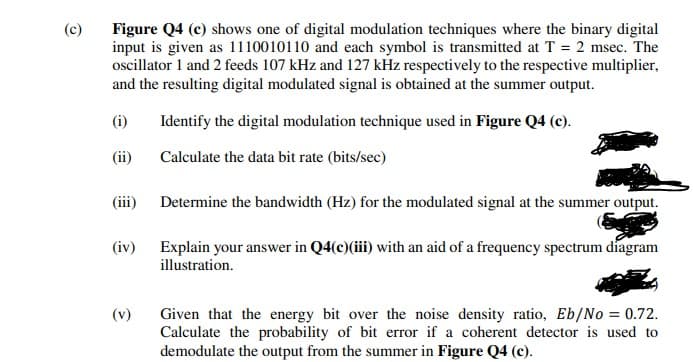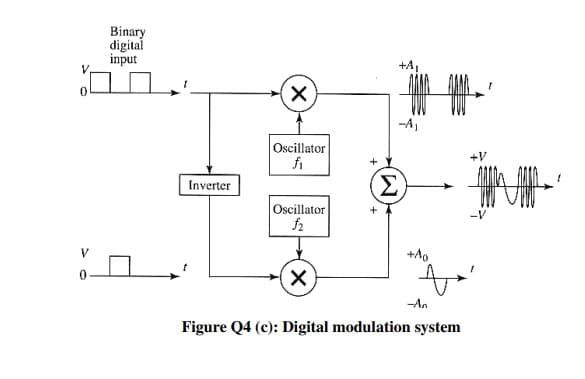Figure Q4 (c) shows one of digital modulation techniques where the binary digital input is given as 1110010110 and each symbol is transmitted at T = 2 msec. The oscillator 1 and 2 feeds 107 kHz and 127 kHz respectively to the respective multiplier, and the resulting digital modulated signal is obtained at the summer output. (i) Identify the digital modulation technique used in Figure Q4 (c). (ii) Calculate the data bit rate (bits/sec) (iii) Determine the bandwidth (Hz) for the modulated signal at the summer output.
Figure Q4 (c) shows one of digital modulation techniques where the binary digital input is given as 1110010110 and each symbol is transmitted at T = 2 msec. The oscillator 1 and 2 feeds 107 kHz and 127 kHz respectively to the respective multiplier, and the resulting digital modulated signal is obtained at the summer output. (i) Identify the digital modulation technique used in Figure Q4 (c). (ii) Calculate the data bit rate (bits/sec) (iii) Determine the bandwidth (Hz) for the modulated signal at the summer output.
Introductory Circuit Analysis (13th Edition)
13th Edition
ISBN:9780133923605
Author:Robert L. Boylestad
Publisher:Robert L. Boylestad
Chapter1: Introduction
Section: Chapter Questions
Problem 1P: Visit your local library (at school or home) and describe the extent to which it provides literature...
Related questions
Question

Transcribed Image Text:Figure Q4 (c) shows one of digital modulation techniques where the binary digital
input is given as 1110010110 and each symbol is transmitted at T = 2 msec. The
ocillator 1 and 2 feeds 107 kHz and 127 kHz respectively to the respective multiplier,
and the resulting digital modulated signal is obtained at the summer output.
(c)
(i)
Identify the digital modulation technique used in Figure Q4 (c).
(ii)
Calculate the data bit rate (bits/sec)
(iii)
Determine the bandwidth (Hz) for the modulated signal at the summer output.
(iv)
Explain your answer in Q4(c)(iii) with an aid of a frequency spectrum diagram
illustration.
(v)
Given that the energy bit over the noise density ratio, Eb/No = 0.72.
Calculate the probability of bit error if a coherent detector is used to
demodulate the output from the summer in Figure Q4 (c).

Transcribed Image Text:Binary
digital
input
-A1
Oscillator
+V
fi
Σ
Inverter
Oscillator
V
+Ao
-An
Figure Q4 (c): Digital modulation system
Expert Solution
This question has been solved!
Explore an expertly crafted, step-by-step solution for a thorough understanding of key concepts.
Step by step
Solved in 4 steps with 2 images

Knowledge Booster
Learn more about
Need a deep-dive on the concept behind this application? Look no further. Learn more about this topic, electrical-engineering and related others by exploring similar questions and additional content below.Recommended textbooks for you

Introductory Circuit Analysis (13th Edition)
Electrical Engineering
ISBN:
9780133923605
Author:
Robert L. Boylestad
Publisher:
PEARSON

Delmar's Standard Textbook Of Electricity
Electrical Engineering
ISBN:
9781337900348
Author:
Stephen L. Herman
Publisher:
Cengage Learning

Programmable Logic Controllers
Electrical Engineering
ISBN:
9780073373843
Author:
Frank D. Petruzella
Publisher:
McGraw-Hill Education

Introductory Circuit Analysis (13th Edition)
Electrical Engineering
ISBN:
9780133923605
Author:
Robert L. Boylestad
Publisher:
PEARSON

Delmar's Standard Textbook Of Electricity
Electrical Engineering
ISBN:
9781337900348
Author:
Stephen L. Herman
Publisher:
Cengage Learning

Programmable Logic Controllers
Electrical Engineering
ISBN:
9780073373843
Author:
Frank D. Petruzella
Publisher:
McGraw-Hill Education

Fundamentals of Electric Circuits
Electrical Engineering
ISBN:
9780078028229
Author:
Charles K Alexander, Matthew Sadiku
Publisher:
McGraw-Hill Education

Electric Circuits. (11th Edition)
Electrical Engineering
ISBN:
9780134746968
Author:
James W. Nilsson, Susan Riedel
Publisher:
PEARSON

Engineering Electromagnetics
Electrical Engineering
ISBN:
9780078028151
Author:
Hayt, William H. (william Hart), Jr, BUCK, John A.
Publisher:
Mcgraw-hill Education,